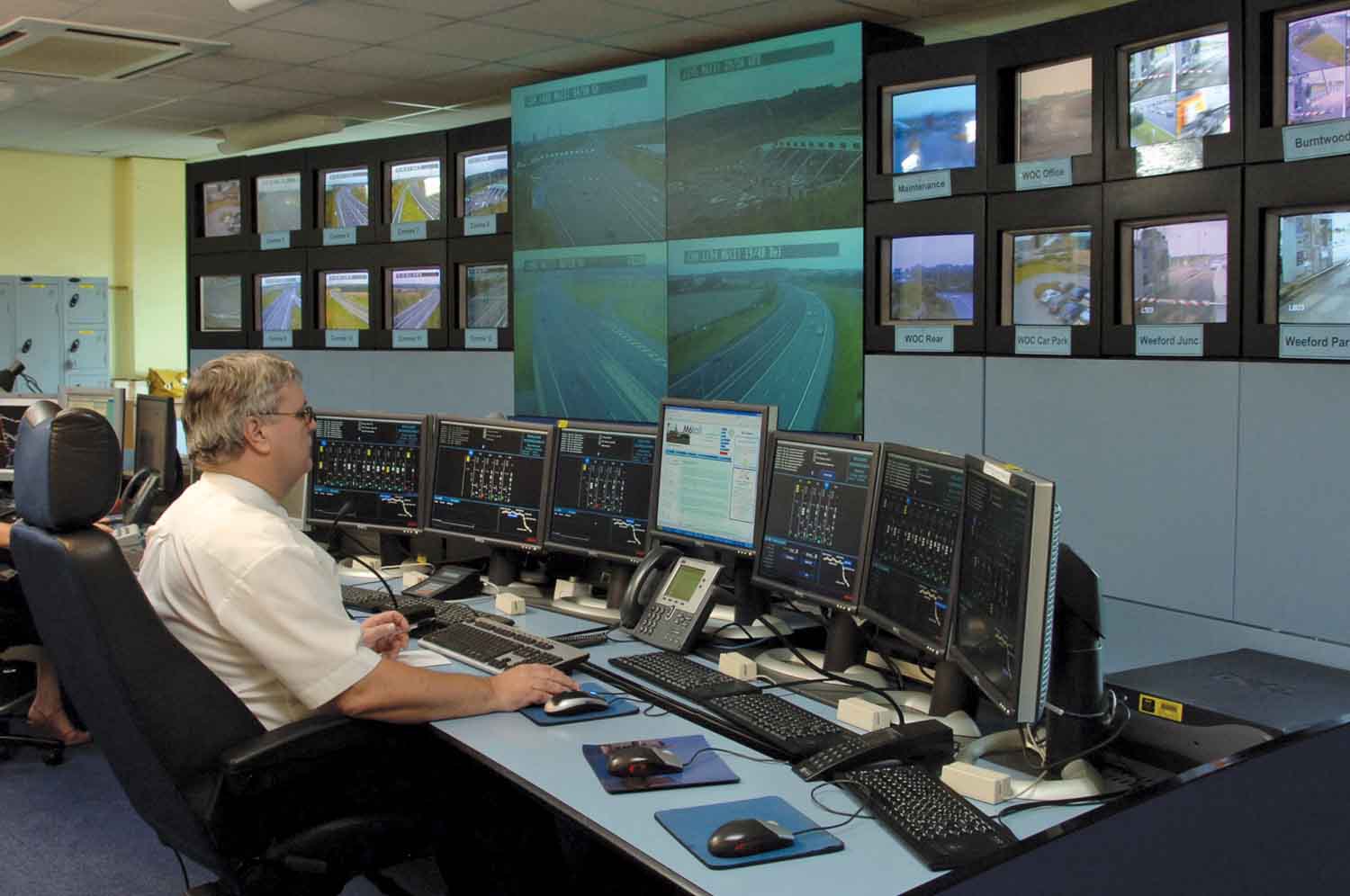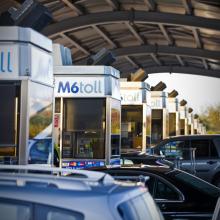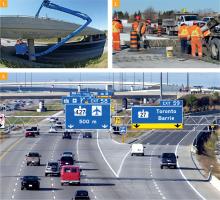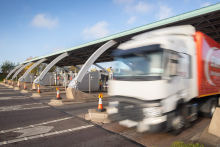For sale: one UK toll motorway along with operating business. Well maintained. Price negotiable. David Arminas looks at what is on offer
As if right on cue, a French articulated truck starts to back up along the hard shoulder at an exit area of M6toll. The manoeuvring is watched from an office inside the nearby M6toll headquarters.
Inside, Andy Pearson, chief executive of M6toll, glances over his shoulder and interrupts his presentation to World Highways. “He’s probably missed the dedicated wide-load

M6toll operations room
For sale: one UK toll motorway along with operating business. Well maintained. Price negotiable. David Arminas looks at what is on offer
As if right on cue, a French articulated truck starts to back up along the hard shoulder at an exit area of M6toll. The manoeuvring is watched from an office inside the nearby M6toll headquarters.
Inside, Andy Pearson, chief executive of M6toll, glances over his shoulder and interrupts his presentation to World Highways. “He’s probably missed the dedicated wide-load lane,” he says. “These things happen.”
The truck reverses only a few metres before turning off to continue its journey.
“We've had people do U-turns in a carriageway or reverse almost a mile back up the road. Vehicles have been confiscated, fines levied or both, even licences taken away,” continues Pearson, who is heading the sale of the 13-year-old motorway.
Transgressions by drivers, either commercial or private, are not unusual in the world of motorways, including M6toll. But M6toll itself is unusual inasmuch as it’s up for sale in a nation where toll roads are scarce. M6toll was Britain’s first toll road when it opened six weeks early in December 2003. Although the UK has numerous toll bridges and tunnels, M6toll remains the nation’s sole toll motorway.
Construction cost for the 43km dual three-lane highway was £900 million in 2003 – almost €1.15 billion using today’s exchange rate. All of it was private cash with no tax-breaks or government subsidies, explains Pearson, who has been chief executive of M6toll since June last year.
He adamantly denies local and national media reports over the years of secret deals done between the owner of M6toll - Midland Expressway Limited (MEL) – and the central government.
M6toll has had “the very highest levels of profitability in terms of EBITDA in the industry”, he says. “We have also had extremely strong traffic growth, good revenue growth, good levels of customer satisfaction and a very good safety record.”
If, as Pearson points out, the business remains profitable and traffic volumes are increasing steadily, why is MEL selling it?
EBITDA - earnings before interest, taxes, depreciation and amortisation - is, correctly, an indicator of a company's financial performance. But EBITDA calculations leave out the cash required to fund working capital, which was M6toll’s problem before refinancing. MEL had been labouring under heavy debt interest payments for construction of the motorway.
Australian Securities Exchange-listed2378 Macquarie Atlas Roads owns 100% of the ordinary equity in Peregrine Motorways Limited, the parent company of MEL. Following the successful 2013 debt restructuring, virtually the entire economic interest in PML is now held, through a “special shareholding arrangement”, by a group of around 27 lending institutions, including Crédit Agricole, Commerzbank and Novo Banco, formerly Banco Espirito Santo. The group also consists of a number of major European banks, including many of which participated in the December 2013 restructuring.
“The only issue we ever had was that we restructured in 2006 just before the recession hit - no one saw that coming,” says Pearson. “We had seen growth and interest rates going up. So we put in a finance package that was in line with that expectation. But then traffic went through the floor and it was tough for four or five years. So we changed our financing package to allow us to be more profitable.”
Then, as part of the following refinancing process between 2013 and 2015, the lenders effectively took economic control of the business, he explains. “The debt restructuring was a very orderly, mutually agreed process, in which the lenders demonstrated their confidence in the business by essentially becoming involved through equity. But they are lenders, not business managers, so clearly at some point they want to move on.”
For sale: toll road
• A 43km (27mile) long, six-lane toll motorway with hard shoulder bypassing the city of Birmingham in central England.
• Structure is a 40mm concrete base with asphalt overlay.
• Opened in December 2003 with a concession up to 2054.
• Average annual daily traffic 2015: 47,600 vehicles
• Total vehicles in 2015: 17.4 million vehicles, of which 89% (15.5 million) were light vehicles, including cars and vans, and 16% were heavy goods vehicles.
• Vehicle growth rate: 10% compound annual growth between 2012 and 2015.
• Toll price changes are at the discretion of M6toll and can be done no more than twice a year.
• Toll collection is pay-as-you-go along with some electronic tag users. Percentage of transactions by method are:
- Cash – 25% (£ sterling and € euro notes accepted)
- Card – 60% (credit and debit cards, including contactless feature)
- Tag – 15% (by way of a dedicated tag lane)So up for sale went M6toll in February.
The road is predominantly a concrete sub-structure with a 40mm asphalt overlay for durability and quiet running. No major physical interventions have been done and the surface is nowhere near the shave-and-pave point. “But we have had some issues that warranted patching of between 300-400 yards,” he says.
Last year a 3.1km stretch of the M42 shared section was resurfaced because it was degrading quickly and more such work will be done on it this year.
“Where we have found areas of standing water, we have designed that out, often with a rolling crown, a new profile of road. There’s been upgrades to safety barriers and more deer fencing. No accidents with deer have yet happened, but after some sightings we stopped traffic to move deer away from the edge of the motorway.”
Can M6toll ever become a totally electronic toll road, or open tolling, like Canada's Highway 407 ETR around Toronto?
“It’s not something we would actively consider at the moment, but it’s horses for courses,” he says.
“There’s the capital investment for cameras and management systems to recognise traffic because not all traffic will have a tag. Then you must manage enforcement, create call centres and follow up customers who haven’t or won't pay. Right now have negligible non-payment - less than a quarter of 1%.”
ETR often works best where there are a lot of repeat users, usually meaning local travel. But only around 15% of M6toll tagged customers are local, typically five or more journeys a month, possible up to 20. Another 15% of customers use credit card and travel about the same frequency. “Probably around 25% of our customers would be in what we call 'frequent user' group. We get a lot of people who only make four journeys a year, even.”
Media reports have insisted that M6toll has never lived up to its target of handling 72,000 vehicles/day, peaking at around 48,000. It’s an exasperating issue for Pearson, who himself insists that there was never any target of 72,000 vehicles/day.
From time to time there are calls from pressure groups and local politicians to take the road into public ownership and make it free. But that wouldn’t solve the congestion problem on the M6 motorway with the vast majority of traffic using it for local journeys.
Work starts
MEL contracted road construction to the CAMBBA consortium consisting of major contractors2435 Carillion, Alfred McAlpine, 1146 Balfour Beatty and AMEC and site clearance started in 2000. MEL was granted concession to operate and maintain the M6 for 53 years, after which the structure will be handed over to the government. Along with the M1 motorway, M6toll forms the main motorway route linking London with key industrial areas of the West Midlands and further north to Scotland. It skirts the city of Birmingham and was formerly called the Birmingham Relief Road. It connects to the M6 motorway at junction 3a and at junction 11A, near the city of Wolverhampton. It has one service area, Norton Canes services, which is being expanded.Distillation of travel data shows that it is used mostly by people bypassing Birmingham, or either leaving the city to travel much further or people arriving from far way. Pearson emphasises the fact that the data shows M6toll is not, therefore, a local road. Nor was it ever intended to be, he says.
In February there was a fatal crash that closed the M6 motorway for several hours. Again, there were calls for M6toll to set aside its toll charge to allow M6 users to avoid the ensuing congestion. It can be a frustrating issue for Pearson.
"You've got to remember, 80% of M6 traffic is local. Most of the through traffic already use M6toll and not the M6. So when there is an incident on the M6 resulting in congestion for a couple of hours, getting onto M6toll may not help due to limited local exits.”
In part answer to critics of the toll road, he points out that there is already an agreement with the government that allows the secretary of state to wave tolls for 24 hours or longer, if there is a significant infrastructure failure on the M6 or other major roads in the region. But it is meant not for short-term major incidents, but for longer periods, such as viaduct failures and diversions needed for, say, three days or a week.
The new owner of M6toll might also like to know what options are available for extending their newly acquired asset. It's a conversation “that takes place every now and then”, he says.
“Now that we are engaging much more with the local authorities, the West Midlands Integrated Transport Authority in particular, we are starting to think how M6toll can help develop the region effectively and I'm sure that is a conversation we will start to have again.”
In fact, in July 2006 the UK transport minister said improvements to the M6 between Birmingham and Manchester would not include a tolled expressway to run broadly parallel with the M6 between junctions 11a – connecting to M6toll - and 19. An expressway would require 50% more land than widening the M6, he noted.
"Having considered all the options, I am clear that the right way forward is for the2309 Highways Agency to focus on delivering one extra lane in each direction on the M6,” said transport secretary at the time, Stephen Ladyman. “I have, therefore, asked the Highways Agency to press ahead with the preparation of detailed proposals. The decision will be welcomed by many local residents and environmental campaigners who prefer the widening option."
No widening of the M6 has taken place.
But in an era of increasing pressure on road infrastructure, the British driving public may be changing its collective mind about toll roads, or at least paying for road use during rush hours. A report by the Independent Transport Commission, published in March, found that 65% of the 2,250 people surveyed would back some kind of pay-as-you-go road use, if not a completely tolled privately operated motorway.
The report found an open mind about such an option, with the highest support, around 26% off those polled, for a peak-time charge on some motorways.
So does the travelling public, in a country not noted for a great love of toll roads – at least in the past - want M6toll extended?
Pearson smiles and opens his arms. “If I had a Pound for every time an M6toll user had said to me they wish the road went right to Manchester, I'd be a rich guy.” Born in Glasgow, Pearson holds a chemical engineering degree from Strathclyde University in Scotland and an MBA from2568 Warwick University in England. Before joining M6toll, he was working with private investors looking at manufacturing opportunities in China.
He previously was with Babcock International in Brazil and the Middle East and was chief executive of Babcock’s UK rail construction business. Before that, he was 20 years in engineering and manufacturing groups including Swedish packaging business SCA, fabric and fibre manufacturer Courtaulds and consumer goods maker Unilever.
As if right on cue, a French articulated truck starts to back up along the hard shoulder at an exit area of M6toll. The manoeuvring is watched from an office inside the nearby M6toll headquarters.
Inside, Andy Pearson, chief executive of M6toll, glances over his shoulder and interrupts his presentation to World Highways. “He’s probably missed the dedicated wide-load lane,” he says. “These things happen.”
The truck reverses only a few metres before turning off to continue its journey.
“We've had people do U-turns in a carriageway or reverse almost a mile back up the road. Vehicles have been confiscated, fines levied or both, even licences taken away,” continues Pearson, who is heading the sale of the 13-year-old motorway.
Transgressions by drivers, either commercial or private, are not unusual in the world of motorways, including M6toll. But M6toll itself is unusual inasmuch as it’s up for sale in a nation where toll roads are scarce. M6toll was Britain’s first toll road when it opened six weeks early in December 2003. Although the UK has numerous toll bridges and tunnels, M6toll remains the nation’s sole toll motorway.
Construction cost for the 43km dual three-lane highway was £900 million in 2003 – almost €1.15 billion using today’s exchange rate. All of it was private cash with no tax-breaks or government subsidies, explains Pearson, who has been chief executive of M6toll since June last year.
He adamantly denies local and national media reports over the years of secret deals done between the owner of M6toll - Midland Expressway Limited (MEL) – and the central government.
M6toll has had “the very highest levels of profitability in terms of EBITDA in the industry”, he says. “We have also had extremely strong traffic growth, good revenue growth, good levels of customer satisfaction and a very good safety record.”
If, as Pearson points out, the business remains profitable and traffic volumes are increasing steadily, why is MEL selling it?
EBITDA - earnings before interest, taxes, depreciation and amortisation - is, correctly, an indicator of a company's financial performance. But EBITDA calculations leave out the cash required to fund working capital, which was M6toll’s problem before refinancing. MEL had been labouring under heavy debt interest payments for construction of the motorway.
Australian Securities Exchange-listed
“The only issue we ever had was that we restructured in 2006 just before the recession hit - no one saw that coming,” says Pearson. “We had seen growth and interest rates going up. So we put in a finance package that was in line with that expectation. But then traffic went through the floor and it was tough for four or five years. So we changed our financing package to allow us to be more profitable.”
Then, as part of the following refinancing process between 2013 and 2015, the lenders effectively took economic control of the business, he explains. “The debt restructuring was a very orderly, mutually agreed process, in which the lenders demonstrated their confidence in the business by essentially becoming involved through equity. But they are lenders, not business managers, so clearly at some point they want to move on.”
For sale: toll road
• A 43km (27mile) long, six-lane toll motorway with hard shoulder bypassing the city of Birmingham in central England.
• Structure is a 40mm concrete base with asphalt overlay.
• Opened in December 2003 with a concession up to 2054.
• Average annual daily traffic 2015: 47,600 vehicles
• Total vehicles in 2015: 17.4 million vehicles, of which 89% (15.5 million) were light vehicles, including cars and vans, and 16% were heavy goods vehicles.
• Vehicle growth rate: 10% compound annual growth between 2012 and 2015.
• Toll price changes are at the discretion of M6toll and can be done no more than twice a year.
• Toll collection is pay-as-you-go along with some electronic tag users. Percentage of transactions by method are:
- Cash – 25% (£ sterling and € euro notes accepted)
- Card – 60% (credit and debit cards, including contactless feature)
- Tag – 15% (by way of a dedicated tag lane)So up for sale went M6toll in February.
The road is predominantly a concrete sub-structure with a 40mm asphalt overlay for durability and quiet running. No major physical interventions have been done and the surface is nowhere near the shave-and-pave point. “But we have had some issues that warranted patching of between 300-400 yards,” he says.
Last year a 3.1km stretch of the M42 shared section was resurfaced because it was degrading quickly and more such work will be done on it this year.
“Where we have found areas of standing water, we have designed that out, often with a rolling crown, a new profile of road. There’s been upgrades to safety barriers and more deer fencing. No accidents with deer have yet happened, but after some sightings we stopped traffic to move deer away from the edge of the motorway.”
Can M6toll ever become a totally electronic toll road, or open tolling, like Canada's Highway 407 ETR around Toronto?
“It’s not something we would actively consider at the moment, but it’s horses for courses,” he says.
“There’s the capital investment for cameras and management systems to recognise traffic because not all traffic will have a tag. Then you must manage enforcement, create call centres and follow up customers who haven’t or won't pay. Right now have negligible non-payment - less than a quarter of 1%.”
ETR often works best where there are a lot of repeat users, usually meaning local travel. But only around 15% of M6toll tagged customers are local, typically five or more journeys a month, possible up to 20. Another 15% of customers use credit card and travel about the same frequency. “Probably around 25% of our customers would be in what we call 'frequent user' group. We get a lot of people who only make four journeys a year, even.”
Media reports have insisted that M6toll has never lived up to its target of handling 72,000 vehicles/day, peaking at around 48,000. It’s an exasperating issue for Pearson, who himself insists that there was never any target of 72,000 vehicles/day.
From time to time there are calls from pressure groups and local politicians to take the road into public ownership and make it free. But that wouldn’t solve the congestion problem on the M6 motorway with the vast majority of traffic using it for local journeys.
Work starts
MEL contracted road construction to the CAMBBA consortium consisting of major contractors
In February there was a fatal crash that closed the M6 motorway for several hours. Again, there were calls for M6toll to set aside its toll charge to allow M6 users to avoid the ensuing congestion. It can be a frustrating issue for Pearson.
"You've got to remember, 80% of M6 traffic is local. Most of the through traffic already use M6toll and not the M6. So when there is an incident on the M6 resulting in congestion for a couple of hours, getting onto M6toll may not help due to limited local exits.”
In part answer to critics of the toll road, he points out that there is already an agreement with the government that allows the secretary of state to wave tolls for 24 hours or longer, if there is a significant infrastructure failure on the M6 or other major roads in the region. But it is meant not for short-term major incidents, but for longer periods, such as viaduct failures and diversions needed for, say, three days or a week.
The new owner of M6toll might also like to know what options are available for extending their newly acquired asset. It's a conversation “that takes place every now and then”, he says.
“Now that we are engaging much more with the local authorities, the West Midlands Integrated Transport Authority in particular, we are starting to think how M6toll can help develop the region effectively and I'm sure that is a conversation we will start to have again.”
In fact, in July 2006 the UK transport minister said improvements to the M6 between Birmingham and Manchester would not include a tolled expressway to run broadly parallel with the M6 between junctions 11a – connecting to M6toll - and 19. An expressway would require 50% more land than widening the M6, he noted.
"Having considered all the options, I am clear that the right way forward is for the
No widening of the M6 has taken place.
But in an era of increasing pressure on road infrastructure, the British driving public may be changing its collective mind about toll roads, or at least paying for road use during rush hours. A report by the Independent Transport Commission, published in March, found that 65% of the 2,250 people surveyed would back some kind of pay-as-you-go road use, if not a completely tolled privately operated motorway.
The report found an open mind about such an option, with the highest support, around 26% off those polled, for a peak-time charge on some motorways.
So does the travelling public, in a country not noted for a great love of toll roads – at least in the past - want M6toll extended?
Pearson smiles and opens his arms. “If I had a Pound for every time an M6toll user had said to me they wish the road went right to Manchester, I'd be a rich guy.” Born in Glasgow, Pearson holds a chemical engineering degree from Strathclyde University in Scotland and an MBA from
He previously was with Babcock International in Brazil and the Middle East and was chief executive of Babcock’s UK rail construction business. Before that, he was 20 years in engineering and manufacturing groups including Swedish packaging business SCA, fabric and fibre manufacturer Courtaulds and consumer goods maker Unilever.







